Growth in Airline Passenger Numbers, Shortage of Pilots, and a Focus on Reducing Emissions will Drive Digital Investments
Flight operations are one of the highest cost centers for an airline. In a growing global aviation market, airlines need to continuously optimize their flight operations and asset utilization to attain enhanced revenues and deliver sustainable operations. Optimizing flight operations can also lower operational expenses and minimize harmful environmental impact, thus enhancing their sustainability efforts. For their operational needs, a majority of the airlines still utilize legacy systems such as baggage management and fuel management, which are currently being upgraded or replaced. Integrating next-generation solutions to these core infrastructure platforms and maintaining them is a key challenge to airlines. Key solution providers and technology-focused start-ups are developing solutions integrated with next-generation technologies like Artificial Intelligence (AI) and Internet of Things (IoT) to help optimize airline operations.
The global concern on rising emissions from the aviation industry has increased airlines’ focus on improving their environmental sustainability initiatives. Reducing fuel usage, developing alternative propulsion solutions, and reducing carbon emissions on the ground are key focus areas. Solution providers and start-ups are developing solutions that can deliver maximum optimization of operations.
Airlines, aviation original equipment manufacturers (OEMs), governments, and universities are working on developing alternate fuels that are cleaner and have minimum effect on the environment. However, a complete replacement of current-day fuels is a long way ahead. In the short term, airlines will be utilizing solutions that can optimize their fuel burn and lead to reduced cost and lower harmful emissions.
There is a rise in interest for integrated end-to-end operations platforms that have a modular architecture. Industry behemoths Airbus and Boeing are leading the race with their Skywise and Boeing Analytx platforms, which provide various solutions that cater to multiple stakeholders such as airlines and MROs. Ensuring sufficient cyber security measures and data anonymization are the key focus areas for solution providers while developing and maintaining these platforms.
There is a rising demand from airlines for solutions that bring efficiencies to their crew management. There is also growing investment in the development of end-to-end crew management solutions that provide multiple features such as crew scheduling optimization, efficient crew transportation, and improved crew performance. This opens up an opportunity for incumbent airline IT solution providers and new entrants to capture the growing demand in the crew management systems market.
The operating expenditures of airlines will keep rising as they add more aircraft to their fleet and new routes to their network. To maintain a strong leash on their financial spending and ensure minimum harmful climate impact, airlines and solution providers will need to work together to implement solutions that integrate next-generation technologies.
Research Scope
- Regional Scope: Global
- Study Type: Market Insight
- Product Scope: Airline IT Systems, Segmentation of Airline Flight Operations, Key Market and Technology Trends
- End-user Scope: IT Solution Providers, Start-ups, Airlines
Key Issues Addressed
- How is the global airline flight operations market segmented, and what are the key activities, challenges, and major optimization projects under each segment?
- What are airlines’ key objectives and requirements that can solve their current obstacles in operations management? What are the key market challenges in airline operations optimization?
- How is technology enabling airlines to optimize their flight operations? What are the major technology trends in airline operations optimization?
- Who are the key solution providers under each segment of this market and what are the major innovative highlights incorporated into their solutions?
Table of Contents
Companies Mentioned (Partial List)
A selection of companies mentioned in this report includes, but is not limited to:
- Airbus
- Boeing








